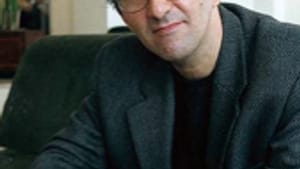Stay in the Loop
BSR publishes on a weekly schedule, with an email newsletter every Wednesday and Thursday morning. There’s no paywall, and subscribing is always free.
A Tolstoy for our century
Roberto Bolaño's '2666'

The Chilean poet/novelist/radical Roberto Bolaño died in 2003 at the age of 50, leaving behind his masterwork, the enigmatically named 2666, which five years later received the National Book Critics Circle Award.
A clue to its title appears in Bolaño's 1999 book Amulet, and the passage where the reference appears also provides an example of the writer's hypnotic prose: "…. a cemetery in the year 2666, a forgotten cemetery under the eyelid of a corpse or an unborn child, bathed in the dispassionate fluids of an eye that tried so hard to forget one particular thing that it ended up forgetting everything else."
It is a glancing, indirect clue at best, like the tone of 2666 itself, which is a splintered, 898-page epic that moves from the charnel house of the Eastern Front in World War II to the musings of an aging black activist in modern-day Detroit to a boxing match in today's Mexico.
Like Russian dolls in prose
Each of the five sections within 2666 is entitled, "The Part About …", and the parts comprise the main tiles in the literary mosaic that is 2666. They are also the equivalent of Russian dolls in prose, each containing seemingly endless secrets and stories, brilliantly translated from the Spanish by Natasha Swimmer.
Bolaño's voice is grave, intimate, serene and compelling, and his range is virtuosic. He knows so much about so much. Each section demonstrates his mastery. In the opening, "The Part About the Critics," he follows the psychic and physical travels of three European literary critics on the trail of the reclusive, wraith-like, Pynchonesque German novelist, the self-named Benno von Archimboldi. On one level, it's a tour de force of the labyrinthine world of seminars and conferences, and on a deeper level a tour of the stirrings within the critics aroused by Archimboldi's books.
As in Dickens, Tolstoy and Cervantes, 2666 provides a dizzying array of characters besides the main players, and each is rendered memorable by a flick of Bolaño's imagination: here a telling dream, there a childhood incident.
"'Meaningful suicide'
A serious playfulness abounds in 2666 as well. In "The Part About Fate," Fate is the nickname of the young black journalist Quincy Williams, who leaves his mother's deathbed in New York to travel to Detroit to interview the aging black activist Barry Seamans for the journal Black Dawn. Bolaño captures Seaman's essence deftly and surely:
"Seaman said he didn't like rap because the only out it offered was suicide. But not even meaningful suicide. I know, I know, he said. It's hard to imagine meaningful suicide. It isn't a common thing. Although I've seen or been near two meaningful suicides. At least I think I have. I could be wrong, he said."
Fate leaves Detroit to continue his surreal odyssey to the fictional Mexican border city of Santa Teresa, a thinly disguised Ciudad Juarez, sitting darkly in the Sonoma desert across from El Paso. The real Juarez is perhaps the world's most blighted city, awash in narco trafficking's wanton slaughter and accompanying police and government corruption.
The wages of NAFTA
Ostensibly Fate has come there to cover a championship boxing match, but his literary purpose is to set the scene for the heart of 2666, "The Part About the Crimes." It's the book's longest section, and in it Bolaño focuses relentlessly on the shamefully under-reported murders in the last two decades of hundreds of young women in Juarez, most of whom worked in the robotic, American-owned, NAFTA-inspired factories called maguiladoras. He catalogues the manner of countless murders, the histories of the victims, the casual police investigations and even the lives of the Santa Teresa detectives.
It's the book's moral and physical epicenter, and hard and brutal reading: Bolaño never flinches, never moralizes, letting the record speak for itself.
Parenthetically, Jennifer Lopez in 2008 released a film called Bordertown, which examined the same evil cinematically but unfortunately never received its just plaudits.
The story has arisen that Roberto Bolaño died of liver complications from earlier heroin use. Despite repeated denials from his family and friends, it sadly persists. It is indeed sad if such rumors detracted one iota from this towering accomplishment.
To read responses, click here and here.
A clue to its title appears in Bolaño's 1999 book Amulet, and the passage where the reference appears also provides an example of the writer's hypnotic prose: "…. a cemetery in the year 2666, a forgotten cemetery under the eyelid of a corpse or an unborn child, bathed in the dispassionate fluids of an eye that tried so hard to forget one particular thing that it ended up forgetting everything else."
It is a glancing, indirect clue at best, like the tone of 2666 itself, which is a splintered, 898-page epic that moves from the charnel house of the Eastern Front in World War II to the musings of an aging black activist in modern-day Detroit to a boxing match in today's Mexico.
Like Russian dolls in prose
Each of the five sections within 2666 is entitled, "The Part About …", and the parts comprise the main tiles in the literary mosaic that is 2666. They are also the equivalent of Russian dolls in prose, each containing seemingly endless secrets and stories, brilliantly translated from the Spanish by Natasha Swimmer.
Bolaño's voice is grave, intimate, serene and compelling, and his range is virtuosic. He knows so much about so much. Each section demonstrates his mastery. In the opening, "The Part About the Critics," he follows the psychic and physical travels of three European literary critics on the trail of the reclusive, wraith-like, Pynchonesque German novelist, the self-named Benno von Archimboldi. On one level, it's a tour de force of the labyrinthine world of seminars and conferences, and on a deeper level a tour of the stirrings within the critics aroused by Archimboldi's books.
As in Dickens, Tolstoy and Cervantes, 2666 provides a dizzying array of characters besides the main players, and each is rendered memorable by a flick of Bolaño's imagination: here a telling dream, there a childhood incident.
"'Meaningful suicide'
A serious playfulness abounds in 2666 as well. In "The Part About Fate," Fate is the nickname of the young black journalist Quincy Williams, who leaves his mother's deathbed in New York to travel to Detroit to interview the aging black activist Barry Seamans for the journal Black Dawn. Bolaño captures Seaman's essence deftly and surely:
"Seaman said he didn't like rap because the only out it offered was suicide. But not even meaningful suicide. I know, I know, he said. It's hard to imagine meaningful suicide. It isn't a common thing. Although I've seen or been near two meaningful suicides. At least I think I have. I could be wrong, he said."
Fate leaves Detroit to continue his surreal odyssey to the fictional Mexican border city of Santa Teresa, a thinly disguised Ciudad Juarez, sitting darkly in the Sonoma desert across from El Paso. The real Juarez is perhaps the world's most blighted city, awash in narco trafficking's wanton slaughter and accompanying police and government corruption.
The wages of NAFTA
Ostensibly Fate has come there to cover a championship boxing match, but his literary purpose is to set the scene for the heart of 2666, "The Part About the Crimes." It's the book's longest section, and in it Bolaño focuses relentlessly on the shamefully under-reported murders in the last two decades of hundreds of young women in Juarez, most of whom worked in the robotic, American-owned, NAFTA-inspired factories called maguiladoras. He catalogues the manner of countless murders, the histories of the victims, the casual police investigations and even the lives of the Santa Teresa detectives.
It's the book's moral and physical epicenter, and hard and brutal reading: Bolaño never flinches, never moralizes, letting the record speak for itself.
Parenthetically, Jennifer Lopez in 2008 released a film called Bordertown, which examined the same evil cinematically but unfortunately never received its just plaudits.
The story has arisen that Roberto Bolaño died of liver complications from earlier heroin use. Despite repeated denials from his family and friends, it sadly persists. It is indeed sad if such rumors detracted one iota from this towering accomplishment.
To read responses, click here and here.
What, When, Where
2666. By Robert Bolaño translated from the Spanish by Natasha Swimmer. Farrar, Straus & Giroux, 2008. 912 pages; $30. www.amazon.com.
Sign up for our newsletter
All of the week's new articles, all in one place. Sign up for the free weekly BSR newsletters, and don't miss a conversation.

 Bob Ingram
Bob Ingram